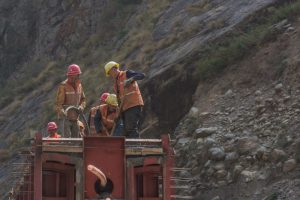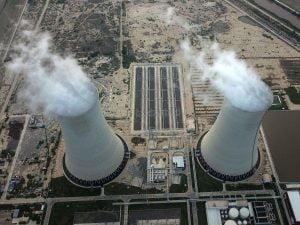In a phone call to the UK Prime Minister Boris Johnson on 26 March, US President Joe Biden said that “democratic countries should have an infrastructure plan to rival China’s Belt and Road initiative”. This statement has been the focus of intense scrutiny in Central Asia, South Asia and Southeast Asia. It is these regions are the most impacted by the Belt and Road Initiative (BRI). They are also desperate for the development aid that any alternative to the BRI must inevitably present.
Almost all countries in these regions are deeply impacted by the climate crisis, while being prone to corruption and an infrastructure development pattern that has led to both authoritarianism and polluting industries. Any response to the BRI must offer them a real alternative.
To date, BRI-supported projects have only exacerbated these problems, especially that of carbon emissions. Part of the reason China has been backing the initiative is a domestic overcapacity in cement and steel, two very carbon-intensive sectors. Ironically, this has allowed China to shift to cleaner technology at home as it funds carbon-heavy projects abroad. Currently, BRI countries are on a trajectory that would exceed the limits of the Paris climate agreement and would contribute to runaway climate breakdown.
US response to China has been mostly security
Over the last two decades the American response to China has been largely security-focused, with intermittent diplomatic or investment initiatives. The Obama administration announced its ‘Asian pivot’ as a way to maintain its status as a Pacific power. Its plan was to draw down defence expenditure in places like the Middle East, while retaining its presence in Asia. The administration also reached out to countries like Vietnam and the Association of Southeast Asian Nations (ASEAN), and backed an ambitious Trans-Pacific Partnership (TPP) trade deal. None of these strategies were sustained. Nor did they offer a coherent approach dealing with the issues of authoritarianism, pollution and climate change that plague the region.
Part of the problem was that the Trump administration reversed some of these decisions, focusing more on the Middle East and quarrelling with its NATO allies. It also pulled out of the TPP. Nevertheless, the US retained its focus on China, with increased emphasis on initiatives like the Quad (the Quadrilateral Security Dialogue) – a partnership between the US, Australia, Japan and India. It introduced the Blue Dot Network, in cooperation with Japan and Australia in 2019. With its focus on infrastructure, there was mention of sustainable development, but this has not gone anywhere. Furthermore, it was merely a certification network, which offered no new investment.
Now with Joe Biden as president, who has made outspoken remarks on China, democracy and climate change, there are higher expectations of a broader response to China, and specifically the BRI.
Neither fish nor fowl
One of the challenges of responding to the BRI is that it is terribly unclear what it is, even to the Chinese. In some ways this is an advantage to the project, as various countries can project their own ideas on the initiative. These range from desperately needed (if risky) investment in Tajikistan to dreams about a railway network in Nepal. It is often the governments of these countries, not China, that are shaping the initiative. For them, it is less grand strategy than grand opportunity.
Part of the nature of the BRI lies in the deep history of these regions. China has projected its assertiveness as a ‘reset’ – a correction of history. Before European colonial powers entered the scene a few centuries ago, a large part of world trade was conducted via land routes. These linked cities like Kashgar in present-day China to places as far afield as Timbuktu, in present-day Mali, famous for its gold mines. Deep-bottomed ocean-going ships disrupted this trade, and sea trade now accounts for approximately 80% of total world trade. As a consequence, empires like Tibet that had risen to power and wealth based on the profits of land-based trade withered and retreated from the world stage. But these routes still exist, and are being re-energised.
A new authoritarian future?
Yet the focus on dreams of the past obscures the fact that BRI projects are now happening in areas with political systems quite unlike what came before them. The direct control that Beijing exercises over areas like Xinjiang and Tibet has no real historical parallel in history: at times they were fiefdoms of empires, or even autonomous empires themselves. Nor does the Kashmir conflict, or even the modern states of India and Pakistan, have any real equivalent in history.
By virtue of this changed context, therefore, the BRI is helping to create a future that is very different from any story of the past. Part and parcel of this future is much more power to centralised institutions in modern states. In Pakistan, the military and federal government have gained more control through the China-Pakistan Economic Corridor (CPEC) projects. Unsurprisingly, accountability and transparency have dwindled further. There has been a similar outcome in Chinese-backed projects in Sri Lanka and Bangladesh. The people of Central Asia, where corruption and state capture are endemic, find it nearly impossible to deal with pollution from Chinese-backed projects, such as cement plants in Kyrgyzstan. Venezuela, one of the key BRI countries in Latin America, is an example of all that can go wrong if these projects are carried through without transparency or community input.
Authoritarianism does not begin, or end, with China
This lack of accountability is not a Chinese creation, or a natural or even necessary outcome of the BRI. World Bank projects in Nepal have systematically failed to incorporate local inputs. This is also true of large hydropower projects across South Asia, whether funded by international agencies or local governments. China may be taking over some of these projects, but neither the Chinese government, nor the BRI, created these problems. India – seen by many as a key component of an infrastructure-led response to China – has fostered similar authoritarian problems. Myanmar’s ethnic cleansing of the Rohingya was partially a land grab for projects supported by both India and China. In Kyrgyzstan, even businesses from places like Canada have allegedly backed authoritarian, corrupt and polluting practices.
Without re-examining their own history of fuelling impunity, no group of governments offers a credible response to the BRI
A successful response to the BRI must bear in mind that, without accountability, any great power rivalry will likely crush vulnerable populations underfoot, along with natural ecosystems. Without re-examining their own history of fuelling impunity, no group of governments offers a credible response to the BRI.
Can innovation be an answer?
As China takes on the mantle of a climate leader, and President Xi Jinping speaks of an “ecological civilisation”, it is past time it is challenged to walk the talk. One way to do so is to focus on green alternatives.
The Biden administration’s Climate Summit in mid-April had the potential to look at this theme. Strikingly Afghanistan was missing from the list of invitees. The US had announced a New Silk Road Initiative for Afghanistan in 2011. At that time, it was seen as a way of expanding economic presence as troops withdrew. Now, 10 years later, the US troops are withdrawing and the New Silk Road is a Chinese enterprise; it is also a carbon-intensive one, exactly like the US idea had been a decade ago. Through the BRI, China has offered opportunities that are as polluting as those offered by the US and its allies in the past. The difference is that the US left and China stayed. In the process the people in the countries where BRI projects are ongoing have received development. The problem is that it is often authoritarian, polluting and corruption-riddled development.
Any real response to the BRI has to offer something better, and something that is there to stay. An emphasis by the US on emerging clean technologies, as well as in an EU-India connectivity partnership, offers some hope. What remains missing is an emphasis on accountability and inclusion. Without this focus, any response to the BRI will only carry into the future the problems of the past.









